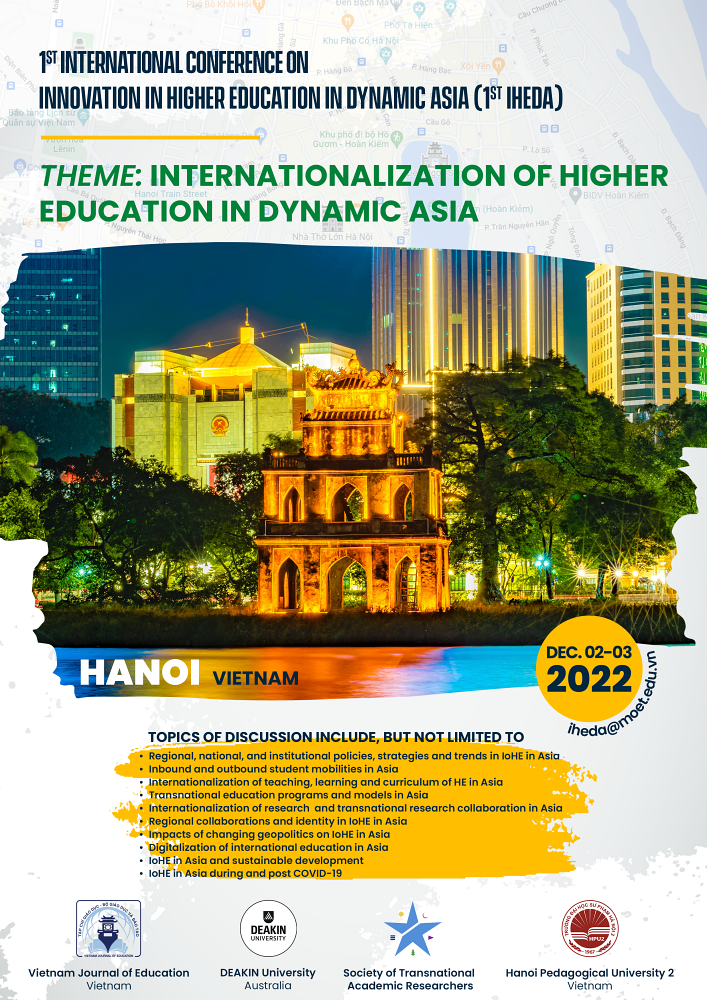Design Learning Activities for the Topic of Microbiology - Biology 10 toward Self-Study Competence Development
DOI:
https://doi.org/10.52296/vje.2022.157- Keywords:
- Self-study competence
- biology 10
- learning activity
-
Downloads
How to Cite
Abstract
Nowadays, the world’s enormous knowledge resources has become more accessible than ever thanks to the support of the Internet and technology. Students and learners are enabled to learn whenever and wherever they want. Teachers have encouraged students to improve their self-study competence to exploit this advantage. Designing the teaching process and activities to develop students’ self-study competence plays an important role in many subjects, including Biology. Therefore, this study proposes a four-step learning process to develop students’ self-study competence. The study also presents an example to illustrate this learning process and help teachers understand what they should do in designing a particular lesson to develop students’ self-study competence.
Downloads
References
Ambarwati, D., & Suyatna, A. (2018). Interactive design for self-study and developing students’ critical thinking skills in electromagnetic radiation topic. Journal of Physics: Conference Series, 948(1), 1-8. https://doi.org/10.1088/1742-6596/948/1/012039
Dang, T. D. T., & Phan, T. H. L. (2018). Designing learning activities to develop self-study competence in teaching Biology 6. Vietnam Journal of Education, 423, 48-51.
Hamel, G., & Prahalad, C. K. (1994). Competing for the future. Harvard Business Review, 72(4), 122-128.
Keitz, T. Z. (1982). Time spent on homework and high school grades: A large-sample path analysis. Journal of Educational Psychology, 74, 248-253.
Krohn, G. A., & O’Conner, C. M. (2005). Student effort and performance over semester. Journal of Economic Education, 36, 3-29. https://doi.org/10.3200/JECE.36.1.3-28
Le, H. D. (2010). Forming and developing self-studying capacity for Maths junior college students. Vinh University.
Le, T. H., & Pham, M. H. (2017). Fostering self-study ability for students in teaching the subject “Geometry optics” (Physics 11) using the B-learning model. Vietnam Journal of Education, special issued in October, 194-197.
Loughran, J. (2005). Researching teaching about teaching: Self-study of teacher education practices. Studying Teacher Education, 1(1), 5-16. https://doi.org/10.1080/17425960500039777
Luong, V. N, & Hoang, T. H. (2005). Portraits of typical education reformers in the world. Tri Thuc Publishing House.
Luong, V. M. (2015). Forming and developing self-studying capacity for students in teaching Physics at Ethnic Preparatory School. Vinh University.
Nguyen, X. T., & Nguyen, Q. U. (2007). General Psychology. University of Education Publishing House.
Nguyen, T. L. N., Le, T. T. H., Nguyen, T. N., & Dang, M. T. (2020). Using Blended learning model in improving self-study competence in Physics subject for high school students. Vietnam Journal of Education, special issued in March, 53-60.
Nonis, S. A., & Hudson, G. I. (2010). Performance of College Students: Impact of Study Time and Study Habits. Journal of Education for Business, 85(4), 229-238. https://doi.org/10.1080/08832320903449550
OECD (2011). Quality Time for Students: Learning in and out of School. OECD Publishing.
Pham, X. M., Le, T. H. (2019). Organize teaching Physics 10 towards developing students’ self-study capacity with the support of Working model software. Vietnam Journal of Education, special issued in November, 180-198.
Phan, T. T. H., & Kieu, T. T. G. (2016). Developing students’ self-study competence in teaching “Induction” (Biology 11). Vietnam Journal of Education, special issued in July, 184-189.
Rhee, K., & Kwaug, S. (2010). The effects of study-time on the variation of academic achievements. The Korean Journal of Survey Research, 11(1), 43-61.
Rubakin, N. A. (1982). How to self-study. Youth Publishing House.
Singh, R. R. (1986). Education in Asia and the Pacific. Retrospect: Prospect.
Sung, K., & Kim, J. (2010). A comparative study on the relationship between private tutoring experiences and high school students’ academic science achievement: Korea, Finland and Japan. Korea Journal of Sociology of Education, 20(1), 103-126. https://doi.org/10.32465/ksocio.2010.20.1.005
Thai, D. T. (2010). Traditional and innovative teaching methods. Vietnam Education Publishing House.
Trinh, Q. L. (2003). Self-Studying in Vietnam. Journal of Science, Can Tho University, 10, 169-175.
Weinert, F. E. (1999). Concept of competence: a conceptual clarification. In Rychen, D. S., & Salganik, L. H. (Eds), Defining and selecting key competencies (Göttingen, Hogrefe).
Downloads
Published
How to Cite
Issue
Section
License
Copyright (c) 2022 Vietnam Journal of Education

This work is licensed under a Creative Commons Attribution 4.0 International License.



















